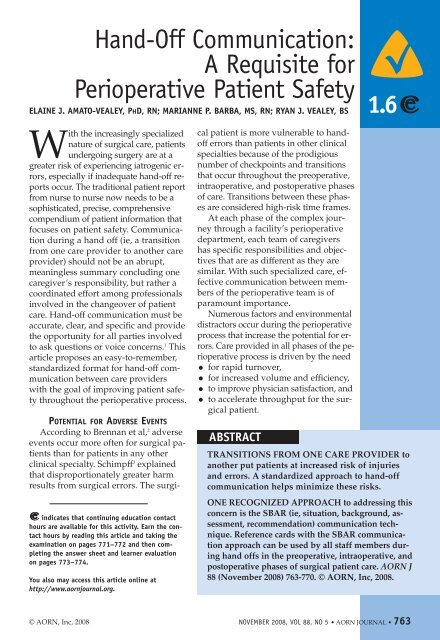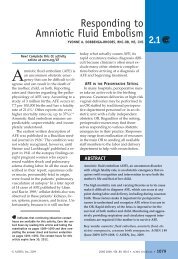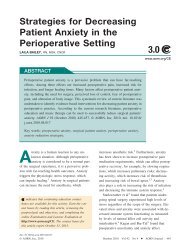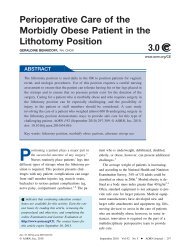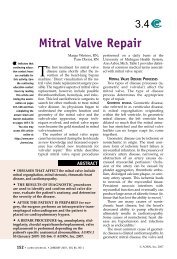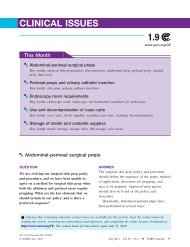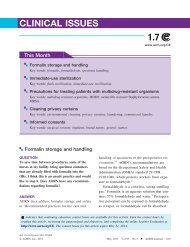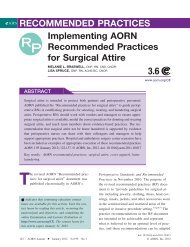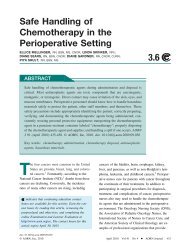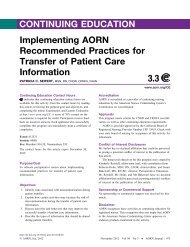Hand-Off Communication: A Requisite for Perioperative ... - AORN
Hand-Off Communication: A Requisite for Perioperative ... - AORN
Hand-Off Communication: A Requisite for Perioperative ... - AORN
You also want an ePaper? Increase the reach of your titles
YUMPU automatically turns print PDFs into web optimized ePapers that Google loves.
<strong>Hand</strong>-<strong>Off</strong> <strong>Communication</strong>:A <strong>Requisite</strong> <strong>for</strong><strong>Perioperative</strong> Patient SafetyELAINE J. AMATO-VEALEY, PHD, RN; MARIANNE P. BARBA, MS, RN; RYAN J. VEALEY, BS1.6With the increasingly specializednature of surgical care, patientsundergoing surgery are at agreater risk of experiencing iatrogenic errors,especially if inadequate hand-off reportsoccur. The traditional patient reportfrom nurse to nurse now needs to be asophisticated, precise, comprehensivecompendium of patient in<strong>for</strong>mation thatfocuses on patient safety. <strong>Communication</strong>during a hand off (ie, a transitionfrom one care provider to another careprovider) should not be an abrupt,meaningless summary concluding onecaregiver’s responsibility, but rather acoordinated ef<strong>for</strong>t among professionalsinvolved in the changeover of patientcare. <strong>Hand</strong>-off communication must beaccurate, clear, and specific and providethe opportunity <strong>for</strong> all parties involvedto ask questions or voice concerns. 1 Thisarticle proposes an easy-to-remember,standardized <strong>for</strong>mat <strong>for</strong> hand-off communicationbetween care providerswith the goal of improving patient safetythroughout the perioperative process.indicates that continuing education contacthours are available <strong>for</strong> this activity. Earn the contacthours by reading this article and taking theexamination on pages 771–772 and then completingthe answer sheet and learner evaluationon pages 773–774.You also may access this article online athttp://www.aornjournal.org.POTENTIAL FOR ADVERSE EVENTSAccording to Brennan et al, 2 adverseevents occur more often <strong>for</strong> surgical patientsthan <strong>for</strong> patients in any otherclinical specialty. Schimpff 3 explainedthat disproportionately greater harmresults from surgical errors. The surgicalpatient is more vulnerable to handofferrors than patients in other clinicalspecialties because of the prodigiousnumber of checkpoints and transitionsthat occur throughout the preoperative,intraoperative, and postoperative phasesof care. Transitions between these phasesare considered high-risk time frames.At each phase of the complex journeythrough a facility’s perioperativedepartment, each team of caregivershas specific responsibilities and objectivesthat are as different as they aresimilar. With such specialized care, effectivecommunication between membersof the perioperative team is ofparamount importance.Numerous factors and environmentaldistractors occur during the perioperativeprocess that increase the potential <strong>for</strong> errors.Care provided in all phases of the perioperativeprocess is driven by the need• <strong>for</strong> rapid turnover,• <strong>for</strong> increased volume and efficiency,• to improve physician satisfaction, and• to accelerate throughput <strong>for</strong> the surgicalpatient.ABSTRACTTRANSITIONS FROM ONE CARE PROVIDER toanother put patients at increased risk of injuriesand errors. A standardized approach to hand-offcommunication helps minimize these risks.ONE RECOGNIZED APPROACH to addressing thisconcern is the SBAR (ie, situation, background, assessment,recommendation) communication technique.Reference cards with the SBAR communicationapproach can be used by all staff members duringhand offs in the preoperative, intraoperative, andpostoperative phases of surgical patient care. <strong>AORN</strong> J88 (November 2008) 763-770. © <strong>AORN</strong>, Inc, 2008.© <strong>AORN</strong>, Inc, 2008 NOVEMBER 2008, VOL 88, NO 5 • <strong>AORN</strong> JOURNAL • 763
Amato-Vealey — Barba — Vealey NOVEMBER 2008, VOL 88, NO 5HAND-OFF COMMUNICATION BETWEEN THE HEALTH CAREFACILITY’S SCHEDULING DEPARTMENT AND THE PREOPERATIVEAREA. One of the first responsibilities of thepreoperative nurse is to obtain the surgeryschedule. The preoperative nurse then ensuresthat the scheduled procedure is consistentwith the patient’s understanding of theprocedure as well as the in<strong>for</strong>med consent,and that both are consistent with the patient’sdiagnosis. The nurse also ensures that all requireddocuments are in place, including thehistory and physical examination (H&P),blood work results, and any other diagnostictest results required <strong>for</strong> surgery. The nurse ensuresthat the surgeon has per<strong>for</strong>med an H&Pupdate be<strong>for</strong>e surgery.The Joint Commission’s Universal Protocol TMhas become a guiding principle <strong>for</strong> all perioperativeteam members and should be appliedto or adapted <strong>for</strong> all operative and other invasiveprocedures. 9 The Universal Protocol isnow included in the overall 2009 Hospital NationalPatient Safety Goals document. 5 Thesurgical verification process must include thefollowing essential elements:• active communication among all membersof the surgical team;• involvement of the patient or a legally designatedrepresentative in the process; and• a requirement <strong>for</strong> site marking that focuseson surgical procedures involving laterality(ie, right/left distinction), multiple structures(eg, fingers, toes), or multiple levels(eg, spine). 9Verification of the correct person, correct site,and correct procedure occurs at the followingtimes including ...anytimetheresponsibility<strong>for</strong> care of the patient is transferred to anothermember of the procedural care team,(including the anesthesia providers) at thetime of, and during, the procedure. 9The patient’s family members may be distractorsin the surgical verification process becauseof the stress they are experiencing fromtheir loved one’s impending surgery. The preoperativenurse should endeavor to involve thepatient’s family members in the verificationprocess at every opportunity to ensure that theyare fully knowledgeable of the process and thecorrect surgical procedure.HAND-OFF COMMUNICATION BETWEEN THE PREOPERATIVEAREA AND THE INTRAOPERATIVE AREA. <strong>Hand</strong>-off communicationimproves patient outcomes when allparticipants take active part in the process. 10 Inthe past, the hand-off communication betweenthe preoperative and intraoperative areassometimes was a short, terse statement or noreport at all. Implementation of a standardizedguide during hand-off communication can increaseefficiency and patient safety and reduceunnecessary redundancy while encouragingbuilt-in redundancy of vital facts. Table 1 outlinesthe SBAR elements of the optimal preoperativeto intraoperative hand-off communication.This transition of care summarizes criticalpatient in<strong>for</strong>mation such as• verifying the correct patient and surgicalprocedure,• reviewing required documents,• discussing patient safety concerns,• assessing preoperative vital signs and painlevel,• identifying cultural implications and theneed <strong>for</strong> family presence, and• verifying that all components of the surgicalprocess have been followed correctly.This hand-off communication serves as abaseline <strong>for</strong> future clinical transfers and ensuresthat patients are safe, secure, and com<strong>for</strong>tableas they are brought to the OR suite.All subsequent actions are based on thishand-off communication.Another component of the Universal Protocolis the surgical time out. 11,12 Be<strong>for</strong>e startingany operative or invasive procedure, a final“time out” verification should be conducted toconfirm the correct patient, procedure, and site.This time out should include ensuring that allrelevant documentation, related in<strong>for</strong>mation,and necessary equipment are available. Althoughthe surgical time out is initiated by adesignated member of the surgical team, all immediatemembers of the surgical team mustparticipate in the time out, during which allother activities are suspended as much as possiblewithout compromising patient safety. Theprocedure is not started until all questions andconcerns have been addressed satisfactorily.<strong>AORN</strong> JOURNAL • 765
NOVEMBER 2008, VOL 88, NO 5Amato-Vealey — Barba — VealeyTABLE 1Elements of thePreoperative to Intraoperative<strong>Hand</strong>-<strong>Off</strong> <strong>Communication</strong>SituationName of patient and date of birthName of operative or invasive procedure tobe per<strong>for</strong>med including modifiers and sitePertinent documents are present andconsistentBackgroundElements of patient history pertinent tosurgeryMedical clearancePatient allergies and NPO statusPatient’s vital signs and pain levelMedication profile and medications takentodaySpecific laboratory resultsCode status of patientAssessmentPatient’s current level of understanding ofthe surgerySpecial patient needs or precautionsPertinent aspects of the patient’s emotionaland spiritual statusPertinent cultural implicationsAnesthesia requestsRecommendationsState whether the patient has been seen preoperativelyby the surgeon and anesthesiacare providerDetermine whether the patient is ready <strong>for</strong>surgeryAllow an opportunity <strong>for</strong> preoperative andintraoperative staff members to ask questionsor voice concernsHAND-OFF COMMUNICATION BETWEEN THE INTRAOPERA-TIVE AREA AND PHASE IPACU.In the past, the patient’sresponse to the surgical experience mayhave been noted in a routine report with littleemphasis on specific surgical events. <strong>Hand</strong>-offcommunication during this transition of careoften occurs when nursing staff members areper<strong>for</strong>ming several tasks simultaneously. Staffmembers should set aside time <strong>for</strong> hand-offcommunication, allowing opportunities to askquestions or to ask <strong>for</strong> clarifications. Table 2outlines the SBAR elements of the intraoperativeto PACU transition, highlighting ORevents that have occurred. Being as specific aspossible is critical. In<strong>for</strong>ming the PACU nurseabout the patient’s past medical history alsomay be vitally important.Components of this transition should includepresenting in<strong>for</strong>mation on how the patienttolerated the procedure and whether theprocedure went as planned. The circulatingnurse should in<strong>for</strong>m the PACU nurse whetherthe patient is hemodynamically stable (eg,heart rate and rhythm) and whether the patientTABLE 2Elements of the Intraoperative toPostanesthesia Care Unit (PACU)<strong>Hand</strong>-<strong>Off</strong> <strong>Communication</strong>SituationName of patient and date of birthName of operative or invasive procedureper<strong>for</strong>med including modifiers and siteBackgroundType of anesthesia administered and nameof anesthesia care providerIntraoperative medications administeredincluding dose and timeIV fluids administeredEstimated blood lossPertinent in<strong>for</strong>mation related to the surgicalsite such as dressings, tubes, drains, orpackingAny significant OR eventsAssessmentHemodynamic stabilityAirway and oxygenation statusThermal status (eg, presence of hypothermiaor hyperthermia)Urine outputPresence or absence of surgical complicationsLevel of painMethod of pain managementRecommendationsEnsure that immediate postoperative ordershave been completedDischarge from the PACU when stableAllow opportunity <strong>for</strong> intraoperative andPACU staff members to ask questions orvoice concerns766 • <strong>AORN</strong> JOURNAL
NOVEMBER 2008, VOL 88, NO 5Amato-Vealey — Barba — VealeyASC secretary asked Mrs L to verify her name,date of birth, and surgical procedure. The secretarynoted that the surgical schedule listedMrs L as being scheduled <strong>for</strong> a “vaginal” hysterectomy.The secretary immediately notifiedthe OR manager of the discrepancy in proceduretype. The OR manager then notified theassigned circulating nurse. The nurse and assignedscrub person worked cooperatively torepick a case cart <strong>for</strong> the corrected procedure,repositioned the OR bed, and reset up theOR <strong>for</strong> an abdominal rather than a vaginalhysterectomy.This error resulted in a surgical delay, whichfrustrated the surgeon. Although the patient understoodthe error and delay, she became veryanxious. Mrs L’s family also was very anxiousand required reassurance that the correct surgerywas going to take place.Using the SBAR communication technique,the preoperative nurse gave the followinghand-off report to the circulating nurse.• Situation—This is Mrs L, date of birth9/21/42, a 66-year-old patient of Dr H.She has been preoperatively prepared <strong>for</strong>an abdominal hysterectomy. All documentation,laboratory reports, and signedin<strong>for</strong>med consent are present in the record.Mrs L’s history and physical examinationare on the chart and have been updated.• Background—For the past three months,Mrs L has experienced postmenopausalbleeding. Furthermore, she has a medicalhistory of atrial fibrillation that is controlledwith diltiazem and warfarin andhas chronic obstructive pulmonary disease(COPD) that is well controlled with anipratropium/albuterol inhaler. As instructedby her surgeon, Mrs L has not taken thewarfarin <strong>for</strong> the past five days. She hasno known allergies and has been NPOsince 10 PM last night.• Assessment—Mrs L experienced a schedulingerror today, so she is extremely nervous.To verify again, she is scheduled toundergo an abdominal hysterectomy.• Recommendations—Mrs L has been seen preoperativelyby her surgeon and her anesthesiacare provider. Do you have any questions?The surgical procedure proceeded withoutincident and the anesthesia care provider andthe circulating nurse transported Mrs L to thePACU. The following hand-off report, whichdid not follow the SBAR technique, took placebetween the circulating nurse, anesthesia careprovider, and PACU nurse:Mrs L—abdominal hysterectomy. Receivedgeneral. Is on her fourth bag of lactatedRinger’s (LR) solution. Minimal blood loss.Dressing is dry. Catheter placed in the OR.Was given ondansetron and morphine in theOR be<strong>for</strong>e coming out.By comparison, the following exchangewould have complied with the Joint Commission’sNational Patient Safety Goal on hand-offcommunication. The circulating nurse andanesthesia care provider could have used theSBAR communication technique and cooperativelyreported the following in<strong>for</strong>mation tothe assigned PACU nurse:• Situation—This is Mrs L, date of birth9/21/42, a 66-year-old patient of Dr H. Shejust underwent an abdominal hysterectomy.• Background—Mrs L has experienced postmenopausalbleeding <strong>for</strong> the past threemonths. Mrs L has no known allergies, butshe has a medical history of atrial fibrillationthat is controlled with diltiazem and warfarin.Mrs L also has COPD that is wellcontrolled with an ipratropium/albuterolinhaler. Mrs L received general anesthesiawith endotracheal intubation and has received3,000 mL IV LR solution duringsurgery. This is her fourth bag of LR. Mrs Lhad approximately 200 mL of blood loss, andher abdominal dressing is dry and intact.• Assessment—Mrs L’s tympanic temperatureis 37° C. An indwelling urinarycatheter was placed in the OR, whichdrained 300 mL of clear urine duringsurgery, and the bag was emptied be<strong>for</strong>etransfer. She was given morphine 4 mgat 10:15 AM and ondansetron 4 mg at10:30 AM. Mrs L’s vital signs when leavingthe OR were 96/64, 78, 16, pulseoximetry 99% on 3 L of oxygen. She is768 • <strong>AORN</strong> JOURNAL
Amato-Vealey — Barba — Vealey NOVEMBER 2008, VOL 88, NO 5hemodynamically stable although she continuesin atrial fibrillation. No complicationsoccurred.• Recommendations—Maintain the patienton 3 L of oxygen by face mask because ofher history of COPD. Discharge her to thepatient care unit when stable. Does anyonehave any questions?As illustrated by the above example, theSBAR communication technique provides muchmore context into which clinical data related tosurgery is communicated. Too often, criticalpieces of the patient’s past medical history areomitted from the hand-off report given by thecirculating nurse and anesthesia care provider tothe PACU nurse because these details are notdeemed “pertinent.” Such omissions can, in fact,be detrimental and even catastrophic <strong>for</strong> the patient.The extra few minutes required to providehand-off communication in a standardized waycan prevent miscommunications from occurring,which could ultimately result in an unnecessaryadverse event.EFFECTIVE HAND-OFF COMMUNICATIONSEffective and standardized communicationbetween care providers at hand-off pointsduring the perioperative process will helpthem facilitate safety and anticipate and limitcomplications. <strong>Communication</strong> that is timely,accurate, complete, unambiguous, and understoodby the recipient reduces error and resultsin improved patient safety.The SBAR mnemonic outlines caregiverconversations to summarize critical patient in<strong>for</strong>mation.With this <strong>for</strong>mat, communicationoccurs effectively with in<strong>for</strong>mation beingtransmitted in the same <strong>for</strong>mat and order,every time. Operationalizing hand-off communicationthroughout the perioperative processcan be challenging; however, <strong>for</strong> each transitionphase, the SBAR technique not only containsunique in<strong>for</strong>mation pertinent to thatphase of care but also provides built-in redundancyof vital facts so that essential in<strong>for</strong>mationis not lost in the process.It is possible that certain errors cannot beavoided during the surgical experience, but acommunication error is not one of them. It is recommendedthat reference cards be created similarto the tables presented in this article. Thesereference cards can be attached to employeeidentification badges <strong>for</strong> quick and easy referenceto facilitate safe patient care and encourageadequate hand-off communication.Editor’s note: The Universal Protocol <strong>for</strong> PreventingWrong Site, Wrong Procedure, Wrong PersonSurgery is a trademark of the Joint Commission,Oakbrook Terrace, IL.REFERENCES1. 2007 National Patient Safety Goals. The Joint Commission.http://www.jointcommission.org/NR/rdonlyres/8912113B-72C6-409F-82A9-77F187424C34/0/07_bhc_npsgs.pdf. Accessed September 25, 2008.2. Brennan TA, Leape LL, Laird NM, et al. Incidenceof adverse events and negligence in hospitalized patients:results of the Harvard Medical Practice StudyI. 1991. Qual Saf Health Care. 2004;13(2):145-151.3. Schimpff SC. Improving operating room andperioperative safety: background and specific recommendations.Surg Innov. 2007;14(2):127-135.4. Effective teamwork as a care strategy: SBAR andother tools <strong>for</strong> improving communication betweencaregivers. Institute <strong>for</strong> Healthcare Improvement.http://www.ihi.org/IHI/Programs/AudioAndWebPrograms/Effective+Teamwork+as+a+Care+Strategy+SBAR+and+Other+Tools+<strong>for</strong>+Improving+<strong>Communication</strong>+Between+Careg.htm?TabId=2. AccessedSeptember 25, 2008.5. 2009 National Patient Safety Goals. The JointCommission. http://www.jointcommission.org/PatientSafety/NationalPatientSafetyGoals. AccessedSeptember 2, 2008.6. Powell SM, Hill RK. My copilot is a nurse—usingcrew resource management in the OR. <strong>AORN</strong> J. 2006;83(1):178-202.7. <strong>AORN</strong> guidance statement: postoperative patientcare in the ambulatory surgery setting. <strong>Perioperative</strong>Standards and Recommended Practices. Denver, CO:<strong>AORN</strong>, Inc; 2008:219-225.8. Groah L. <strong>Hand</strong> offs—a link to improving patientsafety [Patient Safety First]. <strong>AORN</strong> J. 2006;83(1):227-230.9. Universal protocol <strong>for</strong> preventing wrong site,wrong procedure, wrong person surgery. The JointCommission. http://www.jointcommission.org/NR/rdonlyres/AEA17A06-BB67-4C4E-B0FC-DD195FE6BF2A/0/UP_HAP_20080616.pdf. AccessedSeptember 2, 2008.10. Catalano K. JCAHO’S National Patient SafetyGoals 2006. J Perianesth Nurs. 2006;21(1):6-11.11. Universal Protocol UP.01.03.01. The Joint Commission.http://www.jointcommission.org/NR/rdonlyres/F71BC4E9-FEB6-495C-99D8-DB9F0850E75B<strong>AORN</strong> JOURNAL • 769
NOVEMBER 2008, VOL 88, NO 5Amato-Vealey — Barba — Vealey/0/09_NPSG_General_Presentation.ppt#312,51,UniversalProtocol. Accessed September 18, 2008.12. Accreditation Program. Hospital NationalPatient Safety Goals UP.01.03.01. The Joint Commission.http://www.jointcommission.org/NR/rdonlyres/31666E86-E7F4-423E-9BE8-F05BD1CB0AA8/0/HAP_NPSG.pdf. Accessed September 18, 2008.RESOURCESBeyea SC. The National Patient Safety Goals:a focus <strong>for</strong> action [Patient Safety First]. <strong>AORN</strong> J.2006;84(3):485-488.Carr DD. Case managers optimize patient safetyby facilitating effective care transitions. Prof CaseManage. 2007;12(2):70-82.Catalano K, Fickenscher K. Complying with the2008 National Patient Safety Goals. <strong>AORN</strong> J. 2008;87(3):547-556.Crum Gregory BS. Standardizing hand-offprocesses. <strong>AORN</strong> J. 2006;84(6):1059-1061.Knapp C. American Hospital Association-McKessonquest <strong>for</strong> quality prize. Bronson Methodist Hospital:journey to excellence in quality and safety. Joint CommJ Qual Patient Saf. 2006;32(10):556-563.Mikos K. Monitoring handoffs <strong>for</strong> standardization.Nurs Manage. 2007;38(12):16-20.Nemeth CP, O’Connor M, Nunnally M, KlockPA, Cook RI. Distributing cognition: how hand-offcommunication actually works. Department ofAnesthesia and Critical Care, University of Chicago,IL. http://ctlab.protectedsite.net/documents/ASA2005%20<strong>Hand</strong>offs%20POSTER.pdf. Accessed September2, 2008.Patterson ES, Roth EM, Woods DD, Chow R,Gomes JO. <strong>Hand</strong>off strategies in settings with highconsequences <strong>for</strong> failure: lessons <strong>for</strong> health care operations.Int J Qual Health Care. 2004;16(2):125-132.Sandlin D. Improving patient safety by implementinga standardized and consistent approachto hand-off communication. J Perianesth Nurs. 2007;22(4):289-292.Elaine J. Amato-Vealey, PhD, RN, is a nursemanager at Women & Infants’ Hospital, Providence,RI. Dr Amato-Vealey has no declared affiliationthat could be perceived as a potential conflictof interest in publishing this article.Marianne P. Barba, MS, RN, is a facultymember at the University of MassachusettsDartmouth College of Nursing, North Dartmouth.Ms Barba has no declared affiliationthat could be perceived as a potential conflict ofinterest in publishing this article.Ryan J. Vealey, BS, is a medical student III atthe University of Vermont College of Medicine,Burlington. Mr Vealey has no declared affiliationthat could be perceived as a potential conflictof interest in publishing this article.Pine Bark Extract May Reduce Menstrual PainTaking a French maritime pine bark extract mayreduce symptoms of dysmenorrhea, a conditionthat causes extremely painful menstruation, accordingto a June 18, 2008, news release fromNatural Health Science, Inc, Hoboken, New Jersey.Research showed that women taking the extracthad less painful menstrual periods and took fewernonsteroidal anti-inflammatory drugs (NSAIDs)than women taking placebo.The double-blind study, conducted in Japan, included116 women ages 18 to 48 years. The womenkept a diary throughout the six-cycle study to notepain levels and NSAID usage. For the first two cycles,the women did not receive any treatment; <strong>for</strong> thesecond two cycles, they were randomly assigned toreceive either pine bark extract or placebo; and <strong>for</strong>the final two cycles, they discontinued treatment.Analysis showed the number of painful days decreasedfrom an average of 2.1 days prior to treatmentto 1.3 days with pine bark treatment. Whentreatment was discontinued, pain did not immediatelyreturn and NSAID usage did not increase.Dysmenorrhea is believed to be caused by elevatedlevels of inflammation. The pine bark extract wasstudied <strong>for</strong> alleviating symptoms of menstrual painbecause of its natural anti-inflammatory properties.New study: pine bark significantly reduces menstrual pain[news release]. Hoboken, NJ: Natural Health Science, Inc;June 18, 2008.770 • <strong>AORN</strong> JOURNAL
Examination 1.6<strong>Hand</strong>-<strong>Off</strong> <strong>Communication</strong>:A <strong>Requisite</strong> <strong>for</strong> <strong>Perioperative</strong> Patient SafetyPURPOSE/GOALTo educate perioperative nurses about how to operationalize the SBAR (ie, situation, background,assessment, recommendation) technique <strong>for</strong> hand-off communication during perioperativetransitions.BEHAVIORAL OBJECTIVESAfter reading and studying the article on perioperative hand-off communication, nurses will be able to1. define hand-off communication,2. explain how National Patient Safety Goal 02.05.01 addresses hand-off communication,3. describe the SBAR communication technique, and4. explain how to use the SBAR technique in hand-off communication during perioperativetransitions.QUESTIONS1. A hand-off report1. is communication that takes placeduring a patient’s transition from onecare provider to another.2. is a comprehensive compendium ofpatient in<strong>for</strong>mation.3. must be accurate and specific.4. should provide an opportunity <strong>for</strong> allparties involved to ask questions andvoice concerns.5. should focus on the patient’s safety.a. 1 and 3b. 2, 4, and 5c. 2, 3, 4, and 5d. 1, 2, 3, 4, and 52. National Patient Safety Goal 02.05.01states that health care facilities musta. conduct preprocedure verification.b. communicate a complete list of the patient’smedications when the patient istransferred to another setting.c. implement a standardized approach tohand-off communications that includesan opportunity to ask and respond toquestions.d. use at least two patient identifiers whenproviding care, treatment, and services.3. The SBAR technique1. is a concrete mechanism <strong>for</strong> framing aconversation.2. provides a focused way to determinewhat in<strong>for</strong>mation will be communicated.3. can be used to develop teamwork andfoster a culture of patient safety.a. 1b. 2c. 2 and 3d. 1, 2, and 34. The component of the SBAR communicationtechnique during which the relievingcare provider supplies the receiving clinicianwith observations and evaluations ofthe patient’s current state is thea. situation.b. background.c. assessment.d. recommendation.5. One element that is unique to the preoperativeto intraoperative hand-off report iscommunicating© <strong>AORN</strong>, Inc, 2008NOVEMBER 2008, VOL 88, NO 5 • <strong>AORN</strong> JOURNAL • 771
NOVEMBER 2008, VOL 88, NO 5Examinationa. whether the patient has been seen preoperativelyby the surgeon and anesthesiacare provider.b. the name of the operative or invasiveprocedure per<strong>for</strong>med includingmodifiers and site.c. the patient’s hemodynamic stability andthermal status.d. what IV fluids have been administered.6. The intraoperative to postanesthesia careunit (PACU) hand-off communicationshould include1. the type of anesthesia administered.2. the estimated blood loss.3. any significant OR events.4. pertinent in<strong>for</strong>mation related to thesurgical site.a. 1b. 2 and 4c. 1, 2, and 3d. 1, 2, 3, and 47. Specific surgical events do not have tobe relayed during the intraoperative tophase I PACU hand-off communicationbecause nursing staff members are per<strong>for</strong>mingseveral tasks simultaneouslyduring this transition time.a. trueb. false8. One element that is unique to the PACUto inpatient unit hand-off report is communicatingthea. need to provide discharge instructions.b. patient’s airway and oxygenation status.c. presence or absence of surgicalcomplications.d. type of anesthesia administered.9. During the PACU to inpatient unit handoffcommunication, specific emphasis isplaced on medication reconciliation.a. trueb. false10. Elements that are common to all perioperativehand-off communications (eg, preoperativeto intraoperative, intraoperativeto PACU, PACU to inpatient unit) include1. the patient’s name and date of birth.2. the name of the operative or invasiveprocedure.3. any significant OR events.4. the patient’s level of understanding ofthe surgery.5. the opportunity <strong>for</strong> staff members toask questions or state concerns.a. 1 and 3b. 1, 2, and 5c. 2, 3, 4, and 5d. 1, 2, 3, 4, and 5The behavioral objectives and examination<strong>for</strong> this program were preparedby Rebecca Holm, RN, MSN, CNOR,clinical editor, with consultation fromSusan Bakewell, RN, MS, BC, director,Center <strong>for</strong> <strong>Perioperative</strong> Education.Ms Holm and Ms Bakewell haveno declared affiliations that could beperceived as potential conflicts of interestin publishing this article.This program meets criteria <strong>for</strong> CNOR and CRNFA recertification, as well asother continuing education requirements.<strong>AORN</strong> is accredited as a provider of continuing nursing education by theAmerican Nurses Credentialing Center’s Commission on Accreditation.<strong>AORN</strong> recognizes these activities as continuing education <strong>for</strong> registerednurses. This recognition does not imply that <strong>AORN</strong> or The AmericanNurses Credentialing Center approves or endorses products mentionedin the activity.<strong>AORN</strong> is provider-approved by the Cali<strong>for</strong>nia Board of Registered Nursing,Provider Number CEP 13019. Check with your state board of nursing <strong>for</strong>acceptance of this activity <strong>for</strong> relicensure.772 • <strong>AORN</strong> JOURNAL
Answer Sheet 1.6<strong>Hand</strong>-<strong>Off</strong> <strong>Communication</strong>:A <strong>Requisite</strong> <strong>for</strong> <strong>Perioperative</strong> Patient SafetyEvent #08058Session #5039Please fill out the application and answer <strong>for</strong>mon this page and the evaluation <strong>for</strong>m on the backof this page. Tear the page out of the Journal or makephoto copies and mail with appropriate fee to:<strong>AORN</strong> Customer Servicec/o <strong>AORN</strong> Journal Continuing Education2170 S Parker Rd, Suite 300Denver, CO 80231-5711or fax with credit card in<strong>for</strong>mation to(303) 750-3212.Additionally, please verify by signature that youhave reviewed the objectives and read thearticle, or you will not receive credit.Signature ______________________________________1. Record your <strong>AORN</strong> member identification number inthe appropriate section below. (See your membercard.)2. Completely darken the spaces that indicate your answersto examination questions 1 through 10. Use blueor black ink only.3. Our accrediting body requires that we verify the timeyou needed to complete this 1.6 continuing educationcontact hour (96-minute) program. ______4. Enclose fee if in<strong>for</strong>mation is mailed.<strong>AORN</strong> (ID) #____________________________________________Name__________________________________________________Address ________________________________________________City ___________________________________________________ State __________ Zip __________Phone number __________________________________________RN license #____________________________________________ State __________Fee enclosed ___________________________________________or bill the credit card indicated ■ MC ■ Visa ■ American Express ■ DiscoverCard # ___________________________________ Expiration date _____________________Signature _______________________________________________________________ (<strong>for</strong> credit card authorization)Fee: Members $8Nonmembers $16Program offered November 2008The deadline <strong>for</strong> this program is November 30, 2011© <strong>AORN</strong>, Inc, 2008A score of 70% correct on the examination is required <strong>for</strong> credit.Participants receive feedback on incorrect answers.Each applicant who successfully completes this programwill receive a certificate of completion.NOVEMBER 2008, VOL 88, NO 5 • <strong>AORN</strong> JOURNAL • 773
1.6This evaluation is used to determine theextent to which this continuing educationprogram met your learning needs. Rate theseitems on a scale of 1 to 5.Learner Evaluation<strong>Hand</strong>-<strong>Off</strong> <strong>Communication</strong>:A <strong>Requisite</strong> <strong>for</strong> <strong>Perioperative</strong> Patient SafetyPURPOSE/GOALTo educate perioperative nurses about how tooperationalize the SBAR (ie, situation, background,assessment, recommendation) technique<strong>for</strong> hand-off communication duringperioperative transitions.OBJECTIVESTo what extent were the following objectives ofthis continuing education program achieved?1. Define hand-off communication.2. Explain how National Patient Safety Goal02.05.01 addresses hand-off communication.3. Describe the SBAR communication technique.4. Explain how to use the SBAR technique inhand-off communication during perioperativetransitions.CONTENTTo what extent5. did this article increase your know ledgeof the subject matter?6. was the content clear and organized?7. did this article facilitate learning?8. were your individual objectives met?9. did the objectives relate to the overallpurpose/goal?TEST QUESTIONS/ANSWERSTo what extent10. were they reflective of the content?11. were they easy to understand?12. did they address important points?LEARNER INPUT13. Will you be able to use the in<strong>for</strong>mationfrom this article in your work setting?1. yes2. no14. I learned of this article via1. the <strong>AORN</strong> Journal I receive as an <strong>AORN</strong>member.2. an <strong>AORN</strong> Journal I obtained elsewhere.3. the <strong>AORN</strong> Journal web site.15. What factor most affects whether you takean <strong>AORN</strong> Journal continuing educationexamination?1. need <strong>for</strong> continuing education contacthours2. price3. subject matter relevant to currentposition4. number of continuing education contacthours offeredWhat other topics would you like to see addressedin a future continuing education article?Would you be interested or do you knowsomeone who would be interested in writingan article on this topic?Topic(s): ________________________________________________________________________________________________________________________________________________________________Author names and addresses: ___________________________________________________________________________________________________774 • <strong>AORN</strong> JOURNAL • NOVEMBER 2008, VOL 88, NO 5© <strong>AORN</strong>, Inc, 2008


